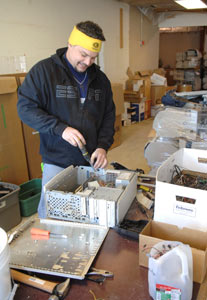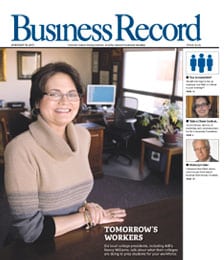Options for recycling electronic waste growing

.floatimg-left-hort { float:left; } .floatimg-left-caption-hort { float:left; margin-bottom:10px; width:300px; margin-right:10px; clear:left;} .floatimg-left-vert { float:left; margin-top:10px; margin-right:15px; width:200px;} .floatimg-left-caption-vert { float:left; margin-right:10px; margin-bottom:10px; font-size: 12px; width:200px;} .floatimg-right-hort { float:right; margin-top:10px; margin-left:10px; margin-bottom:10px; width: 300px;} .floatimg-right-caption-hort { float:left; margin-right:10px; margin-bottom:10px; width: 300px; font-size: 12px; } .floatimg-right-vert { float:right; margin-top:10px; margin-left:10px; margin-bottom:10px; width: 200px;} .floatimg-right-caption-vert { float:left; margin-right:10px; margin-bottom:10px; width: 200px; font-size: 12px; } .floatimgright-sidebar { float:right; margin-top:10px; margin-left:10px; margin-bottom:10px; width: 200px; border-top-style: double; border-top-color: black; border-bottom-style: double; border-bottom-color: black;} .floatimgright-sidebar p { line-height: 115%; text-indent: 10px; } .floatimgright-sidebar h4 { font-variant:small-caps; } .pullquote { float:right; margin-top:10px; margin-left:10px; margin-bottom:10px; width: 150px; background: url(http://www.dmbusinessdaily.com/DAILY/editorial/extras/closequote.gif) no-repeat bottom right !important ; line-height: 150%; font-size: 125%; border-top: 1px solid; border-bottom: 1px solid;} .floatvidleft { float:left; margin-bottom:10px; width:325px; margin-right:10px; clear:left;} .floatvidright { float:right; margin-bottom:10px; width:325px; margin-right:10px; clear:left;}
Wondering what to do with those computers your company replaced last spring, not to mention those old televisions that are starting to pile up at home?
Each year Americans generate an estimated 3 million tons of electronic waste, or e-waste, in the form of outdated computers, televisions and a host of other electronic devices, according to the U.S. Environmental Protection Agency (EPA). That figure is bound to increase substantially this year as many Americans ditch their analog TV sets following the switchover to digital television in June. On top of that, the EPA estimates we have some 460 million outdated electronic devices squirreled away in our homes and businesses that may end up in landfills, leaching toxic substances into our water supplies.
More options
Greater Des Moines residents and businesses have more options than ever for getting rid of e-waste in an environmentally responsible way. In most cases, though, consumers will have to pay a fee if they don’t want their old computer or television to end up in the landfill.
Best Buy Co., for instance, on Feb. 15 will begin accepting televisions and computers at any of its more than 1,000 stores nationwide, with a limit of two devices per person per day. Best Buy will charge $10 for each television or monitor that’s dropped off, but will give consumers a $10 gift card in exchange for the fee.
A few companies that specialize in “demanufacturing” electronics to sell the component materials have also emerged in Greater Des Moines within the past three years. Additionally, Metro Waste Authority recently entered into an agreement that enables it to send e-waste to eastern Iowa for recycling.
Also, some manufacturers, among them Apple Inc., Dell Inc., Sony Corp. and Toshiba Corp., have “takeback” programs in which they will provide free recycling of old computers and other electronics.
“There certainly is a lot of awareness (of the need to recycle electronics),” said Theresa Steiner, a senior environmental specialist with the Iowa Department of Natural Resources (DNR). “We are anticipating there will be some increase (in TVs to dispose of) because of the digital switchover.”
The DNR prohibits landfills from accepting hazardous wastes, which includes computer monitors or televisions that contain cathode ray tubes (CRTs) from commercial sources, but does not specifically prohibit landfills from accepting CRTs that are disposed of by households. “But we do strongly encourage people to recycle them, because they have eight to 10 pounds of lead in them,” Steiner said.
The department in 2007 issued permits for more than 1.6 million pounds and more than 29,000 CRT units to be recycled, which doesn’t reflect contracts that businesses may have with out-of-state recyclers.
Tough business
After a computer or television comes through the door at CP Recovery in Johnston, “very little gets thrown away,” said Mike Polzin, the operations manager. The Omaha-based company, which opened its Johnston branch two years ago, charges 25 cents per pound to take electronic devices. It then “demanufactures” them to collect various precious metals, plastics and other components, which it subsequently sells. The CRTs and other glass are sent to a recycler in Wisconsin.
With or without a recession, “it’s a tough business,” said Polzin, who said the industry is just emerging from a slow period.
“When the economy went down, a lot of people realized they could get paid and started recycling, so the supply went way up,” he said. “And outsourcing to downstream companies may have slowed, which makes it harder for middle companies to get rid of it or get a good price.”
Another e-waste recycler, Midwest Electronic Recovery in Clive, expanded into Greater Des Moines two and a half years ago from Cedar Rapids.
“Since we’re relatively new in the area, our growth has been based on word of mouth,” said Rollie Schultz, the company’s vice president. “But more mom-and-pop businesses are bringing in old computers now because of the new (DNR) regulations (prohibiting dumping of CRTs).” Midwest Electronic Recovery charges 25 cents per pound for anything with glass in it, and 15 cents per pound for any device that uses paper, such as printers and fax machines, but otherwise doesn’t impose a recycling fee.
The Clive facility handles about 860,000 pounds of e-waste annually, Schultz said. It ships computers and televisions to its Cedar Rapids home office for demanufacturing. Metro Waste Authority, which has accepted e-waste for recycling for several years, recently entered into a contract with the Waste Commission of Scott County to handle all the televisions and computers it receives.
Metro Waste charges 50 cents per pound for businesses and individuals, which covers the cost of shipping the items to the Davenport facility. There, the hard drives are shredded, the machines are demanufactured and the CRTs are crushed.
“It’s not a moneymaker for us,” spokeswoman Amy Horst said. “We’re just doing it as a service to our customers. We encourage people to check out other companies. We just ask that they check with the DNR Web site to see if it is on the up and up and has a good standing.”
To view options for e-waste recycling in Iowa, visit the DNR’s Web site at www.iowadnr.gov/waste/recycling/ewaste.html.








